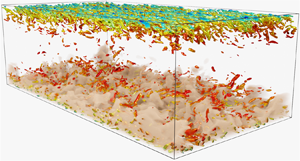Article contents
A finite-size correction model for two-fluid large-eddy simulation of particle-laden boundary layer flow
Published online by Cambridge University Press: 26 February 2021
Abstract

In this paper the capabilities of the turbulence-resolving Eulerian–Eulerian two-phase flow model to predict the suspension of mono-dispersed finite-sized solid particles in a boundary layer flow are investigated. For heavier-than-fluid particles, having settling velocity of the order of the bed friction velocity, the two-fluid model significantly under-estimates the turbulent dispersion of particles. It is hypothesized that finite-size effects are important and a correction model for the drag law is proposed. This model is based on the assumption that the turbulent flow scales larger than the particle diameter will contribute to the resolved relative velocity between the two phases, whereas eddies smaller than the particle diameter will have two effects: (i) they will reduce the particle response time by adding a sub-particle scale eddy viscosity to the drag coefficient, and (ii) they will contribute to increase the production of granular temperature. Integrating finite-size effects allows us to quantitatively predict the concentration profile for heavier-than-fluid particles without any tuning parameter. The proposed modification of the two-fluid model extends its range of applicability to tackle particles having a size belonging to the inertial range of turbulence and allows us to envision more complex applications in terms of flow forcing conditions, i.e. sheet flow, wave-driven transport, turbidity currents and/or flow geometries, i.e. ripples, dunes, scour.
Information
- Type
- JFM Papers
- Information
- Copyright
- © The Author(s), 2021. Published by Cambridge University Press
References
REFERENCES
- 9
- Cited by


